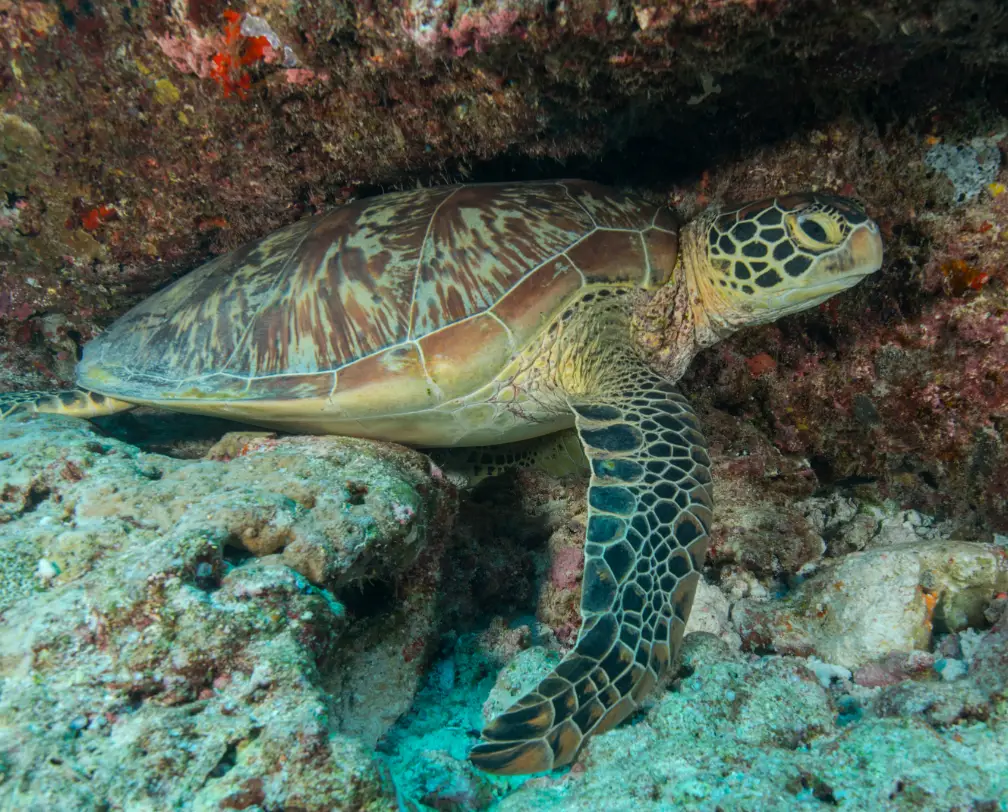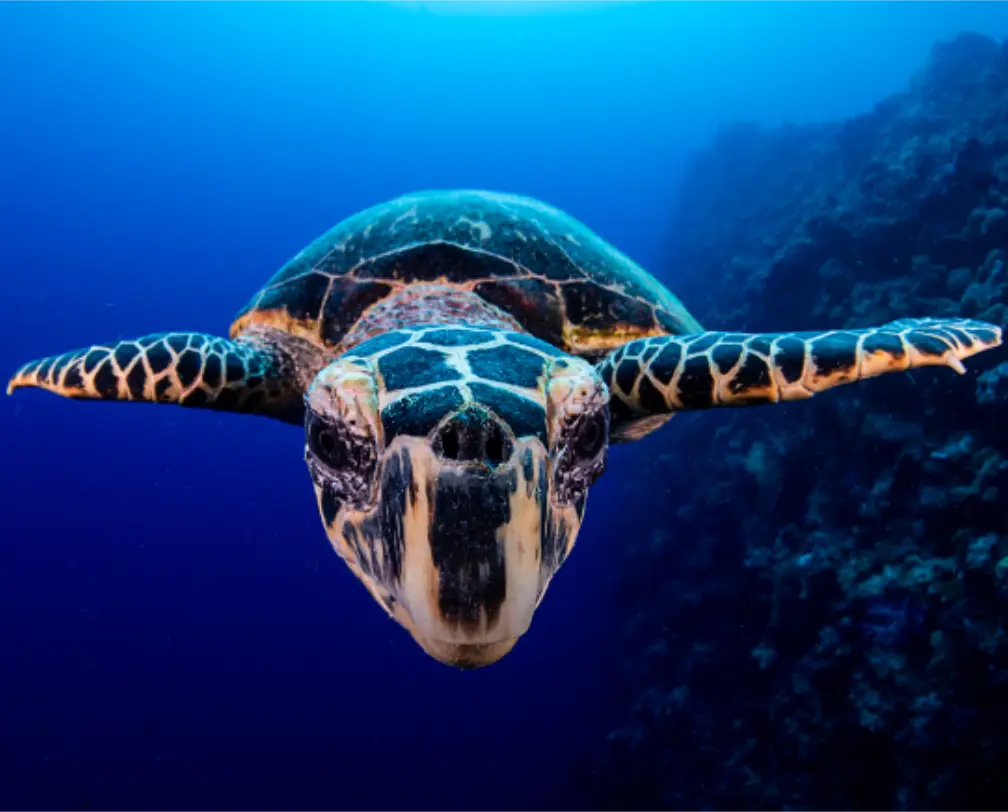Our website is dedicated to providing you with the latest and most accurate information about the creatures that inhabit our oceans. Today, we focus on two of the most beloved sea turtle species - the hawksbill and green sea turtle. These two turtles are not only beautiful to look at, but they also play a crucial role in the marine ecosystem. Join us as we explore the differences between these two species, from their shell shape to their diet and habitat. With a better understanding of these amazing creatures, we hope to inspire you to take action and help protect them for future generations.
Shell shape
The shell shape of the hawksbill and green sea turtles is one of the most noticeable differences between the two species. The hawksbill turtle has a tapered and pointed shell, which is similar to the shape of a bird's beak. The shape of their shell allows them to reach into crevices in coral reefs to find their prey, such as sponges. The shell of the hawksbill turtle is also characterized by a distinctive overlapping scute pattern, with streaks of brown, orange, and gold. This unique pattern is used by researchers to identify individual hawksbill turtles, making it an important tool for conservation efforts.
On the other hand, the green sea turtle has a more rounded and streamlined shell. The shape of their shell allows them to swim more efficiently through the water. The shell of the green sea turtle is typically smoother than the hawksbill turtle's shell, and it has various shades of green, brown, or black. The smooth shell of the green sea turtle is also an important adaptation to reduce drag while swimming.

Color and patterns
The color and patterns of the hawksbill and green sea turtles' shells are another significant difference between the two species. The hawksbill turtle has a shell with a beautiful and unique pattern of scutes, with each scute being a different color. The scutes overlap each other, creating a mosaic-like pattern that makes each hawksbill turtle's shell distinctive. The colors of the hawksbill turtle's shell include brown, gold, and orange, and the pattern is more intricate than any other sea turtle's shell.
In contrast, the green sea turtle has a smoother shell with shades of green, brown, or black. The color of their shell also changes as they grow older. Young green sea turtles have dark-colored shells, while older turtles have a lighter color. Additionally, the carapace of the green sea turtle may have algal growth, which is essential for camouflage in some habitats.
Head shape
The shape of the head is another key difference between the hawksbill and green sea turtles. The hawksbill turtle has a pointed, bird-like beak that they use to reach into crevices in coral reefs for food. The sharp beak helps them tear off chunks of sponges and other invertebrates that they feed on. The beak is also used for defense against predators.
On the other hand, the green sea turtle has a more rounded face with a serrated jaw that helps them cut through seagrass and other vegetation. The jaw's serrations help to break down the vegetation and allow the green sea turtle to ingest it. The serrated jaw is a critical adaptation that allows green sea turtles to be herbivores, unlike other sea turtle species that are mainly carnivorous.

Size
The size of the hawksbill and green sea turtles is also a difference between the two species. Hawksbill turtles are typically smaller in size than green sea turtles. The average length of a hawksbill turtle is 2.5 feet (0.8 meters), and they weigh around 100-150 pounds (45-68 kg). In contrast, green sea turtles can grow up to 4 feet (1.2 meters) in length and weigh over 300 pounds (136 kg).
The difference in size between the two species is due to their adaptation to different habitats and diets. The hawksbill turtle is adapted to living in coral reefs and rocky coastlines, where they need to be agile and maneuverable. Their smaller size allows them to navigate through the reef more easily. The green sea turtle, on the other hand, is adapted to living in seagrass beds, where it's easier to move around even when you are very big.
Habitat and Range
The hawksbill and green sea turtles have different habitats and ranges. The hawksbill turtle is found in tropical and subtropical regions of the Atlantic, Pacific, and Indian Oceans. They are commonly found in coral reefs, rocky coastlines, lagoons, and shallow coastal waters. Hawksbill turtles are known to nest on beaches in over 70 countries worldwide, making them one of the most widely distributed sea turtle species.
In contrast, the green sea turtle is found in warm coastal waters around the world, primarily in tropical and subtropical regions. They are known to live in seagrass beds, coral reefs, and rocky coastlines, and they are also known to migrate long distances between their feeding and nesting sites. Green sea turtles are known to nest on beaches in more than 80 countries worldwide, making them one of the most widespread sea turtle species.
Diet
The diet of the hawksbill and green sea turtles is another difference between the two species. The hawksbill turtle is primarily a carnivore and feeds on a variety of invertebrates, including sponges, jellyfish, sea anemones, and other marine animals. They have a sharp, pointed beak that helps them tear apart their prey, which they usually find in the crevices of coral reefs and rocky coastlines.
On the other hand, the green sea turtle is primarily an herbivore and feeds on seagrass and other types of marine vegetation. They have a serrated jaw that helps them cut through the vegetation, and they are known to eat a wide variety of seagrass species. The diet of the green sea turtle varies depending on their age, sex, and location, and they are known to eat a variety of algae, seaweed, and other plant material as well.
In conclusion, the hawksbill and green sea turtles have different habitats, ranges, and diets. While the hawksbill turtle primarily feeds on invertebrates, the green sea turtle is primarily an herbivore. The hawksbill turtle is commonly found in coral reefs and rocky coastlines, while the green sea turtle is commonly found in seagrass beds. Understanding these differences is important for the conservation of both species, as it allows researchers and conservationists to create targeted conservation plans that cater to their specific needs.


